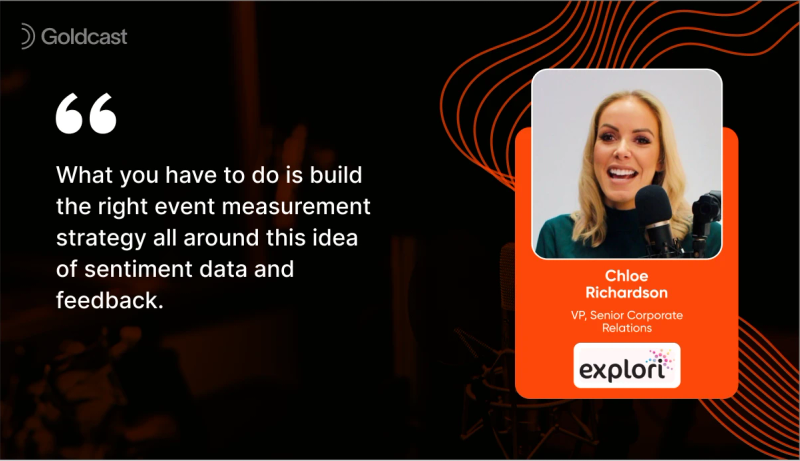The Productivity Hack You've Never Heard Before—Plus, Sentiment Data, Neurodivergent Attendees, and More

Table of Contents
Maximize Your Marketing ROI
Join 10,000 other marketers already getting the best tips on running engaging events that boost pipeline and create raving fans.
Sometimes we think we've heard all the tips, but then one sneaks right in and makes us think twice—like when Chloe Richardson told us at the last Event Marketers Live that her #1 productivity hack is to sleep 10 hours a day.
😳😳😳….say what?! When she told us that it's her top tip for constant energy and the reason she doesn't drink caffeine, we were inspired to mayyyybe go to bed just a little earlier tonight.
And that's what we love about Event Marketers Live. You just never know what you're going to get!
Chloe has been in the events industry for 16 years. From marketing to B2C, trade shows to conferences, and even venue event management—she's truly done it all! Now, as VP Senior Corporate Relations at Explori, she spends her days championing the value and impact that corporate events bring not just to the business, but to the world. And, outside of work, she's Community Engagement Director with the Event Leaders Exchange.
At this particular EML, the panel was rounded out by Austin Sandmeyer, Head of Growth and Customer Marketing at Sendoso. Austin has worked with events for over eight years and currently gets to work with both net new customers and growing and expanding current customer accounts (more on that soon).
Today we'll recap:
- Why data needs to be at the core of your event measurement strategy
- Sentiment data is much bigger than CSAT and NPS
- Stop deprioritizing customers and start expanding instead
- How to include neurodiverse attendees at your events
- Don't sleep on the next EML!
You can watch the full on-demand replay here, too!
Why data needs to be at the core of your event measurement strategy
If you don't already know about Explori, it's a tool specifically for event professionals that helps you assess the value of your events. That makes Chloe a prime person to ask about why data should matter to event marketers. Can't we all just agree that events are awesome and necessary?
Not quite. From Chloe's POV, it makes sense that senior leaders are asking event marketers to fight for their budget. Check out the video below to hear more on this:
Essentially, the cost per attendee for meetings and events is going up. If you don't have a solid way to show event impact on the wider marketing strategy, of course that's going to raise some eyebrows. According to Chloe, on average, one-third of the total marketing budget goes to events. That's no small number!
However, if we don't put money into events, we're missing a huge opportunity. So, what can be done?

The right event measurement strategy is consistent, standardized, clearly defined, and looks at both individual events and the entire events channel as a whole. You should be demonstrating the performance of your events program in a way that your stakeholders inherently understand. Think about it from a CFO perspective—if every department except marketing can give you clear insights and dashboards, wouldn't that be a red flag for you?
This is why data equals business insights. Without accurate data, you can't benchmark or compare your year-over-year performance. You lose your ability to be strategic and think big-picture when you don't have data to analyze.
Sentiment data is much bigger than CSAT and NPS
There are three major types of data you should be collecting to prove event impact:
- Demographics: We all know about this category. These are questions like: Who is attending your event? What are people's job titles? Who do they work for?
- Engagement data: What are people doing at your event? How are they interacting with the host or other attendees? What are they clicking on?
- Sentiment data: This is the real strategic, powerful data type—and the one that's often missed. It's generally collected through post-event feedback, and it holds the key to the true value of your events channel because it lets you understand the feelings and attitudes of your attendees.
Sentiment data tells you why people did what they did and, most importantly, what they plan on doing in the future. It shows you how your event has actually influenced the way an individual person will behave! That's much more important than knowing that, say, 40% of your audience are entry-level marketers or 30% of your audience are women.
Chloe explained that, depending on your event objectives, sentiment data will give you robust metrics that can link events to other things; for example, increased employee productivity due to a sales kickoff, or propensity to purchase based on an interaction at a trade show.
Many times, sentiment data is the missing link across huge corporate event programs. Adding it elevates the other data points you're already collecting and helps you to finally quantify your event impact. Once you can show senior leadership how your events are impacting customer, prospect, and employee behavior, you're so much closer to getting executive buy-in.
Stop deprioritizing customers and start expanding instead
As someone in a position where he has to focus on both existing and new customers, we were curious about how Austin strikes a balance between the two. Watch the clip below to find out:
Customers have been deprioritized for so long in favor of new leads and prospects. We can get so stuck on attracting net new folks to our audience that we forget about our loyal customers. However, those are the very people we need to retain for our business to stay strong!
There's also an opportunity with each existing customer to expand and get more value from that relationship.
"How do I really expand that relationship and that use case and make it even stickier? That's where I'm seeing the real value." - Austin Sandmeyer, Head of Growth and Customer Marketing at Sendoso
At the end of the day, you may be able to get awesome intent data about people that match your ICP, but you still don't know them yet. They haven't had conversations with your salespeople or made a purchase from you.
Meanwhile, you have all these people who have done those things that could become better users of your product or expand into using other products or services—and you have much more data on your current customers than your prospects. That's worth exploring!
One way that the Sendoso team has been nurturing their customers has been through customer events, which bring folks together and allow them to network, learn from each other, and ultimately sell other customers on different solutions. The value of these interactions, however quick, can be astronomical!
How to include neurodiverse and intergenerational attendees at your events
We've talked before about the importance of inclusivity at events, and attendee expectations are only rising.
Chloe introduced everyone to her neurodiversity badge, as well as Google's The Neu Project, a community working together to make event spaces more welcoming for neurodivergent people.
While there are many diversities you can see, there are also many you can't, and The Neu Project helps remind us of that. For folks with autism, ADHD, and other neurodivergent diversities, donning a badge can help others understand when it's appropriate to strike up a conversation or whether a sensitive approach could be beneficial.
Marketers should also be thinking about younger generations in the audience. As Gen Z becomes more prominent in the workforce, they're going to want more engaging, punchier sessions—not the traditional 50-minute panels or lectures of the recent past. Instead, ask people in the audience what they think. Ask folks to contribute! Make sure they feel included, which is the literal definition of being inclusive.
Another suggestion here is to offer different options for attendees. Maybe some of your events are casual coffee chats, while others do center around a speaker panel with time for Q&A (and engagement touchpoints sprinkled throughout, of course). You could also host 1:1 networking events for people who prefer talking with just one person versus a big group. That way, there's something for everyone.
PS: If you don't know what your attendees want, ask them! Use surveys to ascertain what people are looking for and then, when you deliver on those expectations, let them know. Tell people, "We're hosting this event because it was our top request this year." That closes the feedback loop and lets your audience know you value and act on their feedback.
Don't sleep on the next EML!
We'd love to see you for the next Event Marketers Live! You'll meet other demand generation and event marketing professionals, get to offer your POV in the chat and polls, and, of course, learn from amazing experts like Chloe and Austin. Register below, and we'll see you soon!
Transform Your Video Marketing with AI
Stay In Touch
Platform
Resources
© 2026 Copyright Goldcast, Inc. All rights reserved.





 Upcoming Events
Upcoming Events Event Series
Event Series On-Demand Events
On-Demand Events

